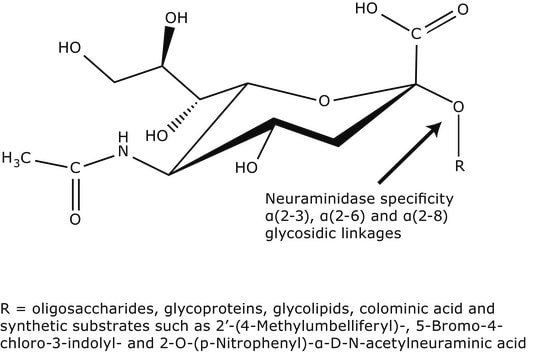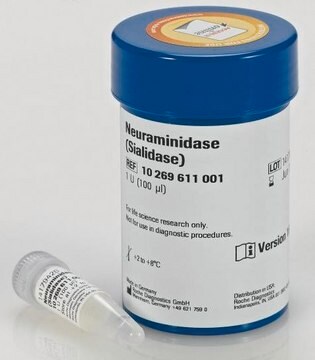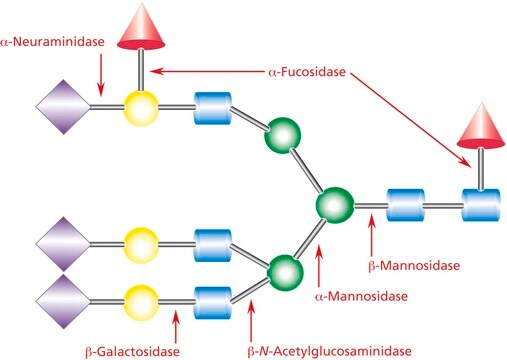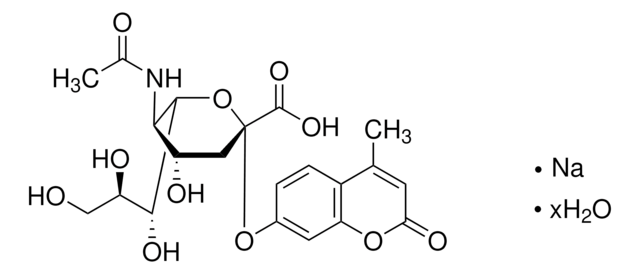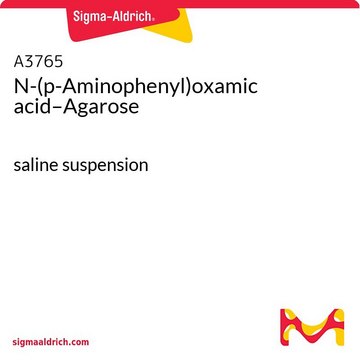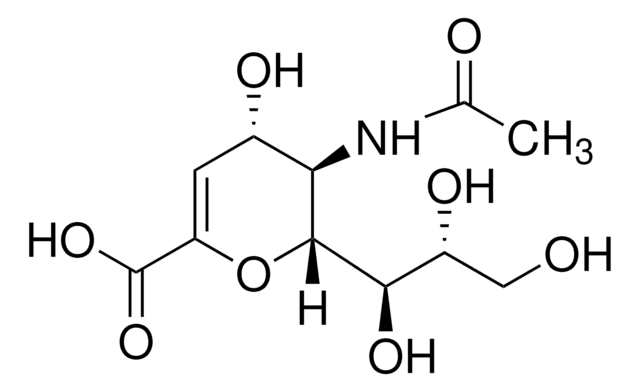N3001
Neuraminidase from Clostridium perfringens (C. welchii)
Type VI, lyophilized powder, 6-15 units/mg protein (using 4MU-NANA), 2-10 units/mg protein (mucin)
Synonym(s):
Acyl-neuraminyl Hydrolase, Receptor-destroying enzyme, Sialidase
Sign Into View Organizational & Contract Pricing
All Photos(1)
About This Item
Recommended Products
biological source
Clostridium perfringens str. 13
Quality Level
type
Type VI
form
lyophilized powder
specific activity
2-10 units/mg protein (mucin)
6-15 units/mg protein (using 4MU-NANA)
composition
Protein, ≥50% biuret
storage temp.
−20°C
Gene Information
Clostridium perfringens str. 13 ... nanI(988807)
Looking for similar products? Visit Product Comparison Guide
General description
Neuraminidase enzymes are hydrolase enzymes that promote influenza virus release from infected cells and facilitate virus spread.
Application
Neuraminidase from Clostridium perfringens (C. welchii) has been used in a study to assess a glycoprotein faction suitable for use as a substrate in preparation assays. It has also been used in a study to investigate the action of an epsilion-toxin on MDCK cells.
Biochem/physiol Actions
Neuraminidase cleavage of sialic acid groups has been used to study recognition by antibodies of glycoprotein structures. The use of neuraminidase in the estimation of N-acetylneuraminic acid was compared favorably to two other methods.
Neuraminidase from Clostridium perfringens reduces the viability of human leukemic myeloblasts and attenuates their ability to activate lymphocytes.
Neuraminidases are used to cleave terminal N-acetyl neuraminic acid (sialic acid) from a variety of glycoproteins. The enzyme from Clostridium perfringens cleaves terminal sialic acid residues which are α-2,3- α-2,6- or α-2,8-linked to Gal, GlcNac, GalNAc, AcNeu, GlcNeu, oligosaccharides, glycolipids or glycoproteins. The relative rate of cleavage decreases in the order: α-2-3 > α-2-6 . α-2-8. Neuraminidase from C. perfringens cleaves α-2-3 linked sialic acid residues most efficiently, compared to A. ureafaciens, (Sigma N3642) which preferentially cleaves α-2-6 linked residues.
The use of neuraminidase to remove sialic acid residues from glycoproteins on cell surfaces has been frequently reported. Generally, procedures have indicated using neuraminidase in PBS at 37°C for 30 minutes, followed by several washings with PBS. Treatment of tissue sections with neuraminidase at much lower concentrations require longer incubation: for 1-4 U/mL in 0.1 M acetate buffer pH 4.2-5, from 2 to 20 hours at 37 °C.
Preparation Note
Chromatographically purified from Type V (N 2876)
Analysis Note
Package sizes based on 4MU-NANA units
Package sizes based on the 4MU-NANA units
Signal Word
Danger
Hazard Statements
Precautionary Statements
Hazard Classifications
Resp. Sens. 1
Storage Class Code
11 - Combustible Solids
WGK
WGK 1
Flash Point(F)
Not applicable
Flash Point(C)
Not applicable
Personal Protective Equipment
dust mask type N95 (US), Eyeshields, Gloves
Choose from one of the most recent versions:
Already Own This Product?
Find documentation for the products that you have recently purchased in the Document Library.
Customers Also Viewed
C Ogier et al.
Biomedicine / [publiee pour l'A.A.I.C.I.G.], 31(9-10), 250-252 (1979-12-01)
The effect of increasing concentrations of Cl. Perfringens neuraminidase and of pH on the dye exclusion ability and lymphocyte stimulating capacity of leukemic myeloblasts was studied. The higher the neuraminidase concentration, or the lower the pH was, the more myeloblasts
Ana León-Rodríguez et al.
Scientific reports, 12(1), 11581-11581 (2022-07-09)
Short-term behavioral alterations are associated with infection and aid the recovery from sickness. However, concerns have raised that sustained behavioral disturbances after acute neuroinflammation could relate to neurological diseases in the long run. We aimed to explore medium- and long-term
L Petit et al.
Journal of bacteriology, 179(20), 6480-6487 (1997-10-23)
Epsilon-toxin is produced by Clostridium perfringens types B and D and is responsible for a rapidly fatal enterotoxemia in animals, which is characterized by edema in several organs due to an increase in blood vessel permeability. The Madin-Darby canine kidney
A G Fraser et al.
Journal of medical microbiology, 8(2), 235-249 (1975-05-01)
A glycoprotein fraction (fraction VII) suitable for use as a substrate in assays of microbial neuraminidase was prepared from pooled human plasma. It is pasteurised during preparation to eliminate the risk of transmission of serum hepatitis. This results in polymerisation
Gangliosides: structure, isolation, and analysis.
R W Ledeen et al.
Methods in enzymology, 83, 139-191 (1982-01-01)
Protocols
Our team of scientists has experience in all areas of research including Life Science, Material Science, Chemical Synthesis, Chromatography, Analytical and many others.
Contact Technical Service